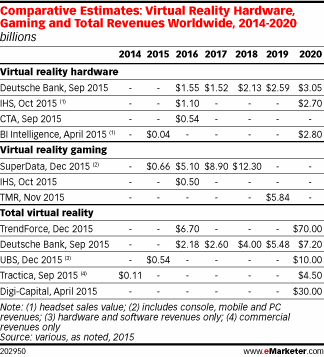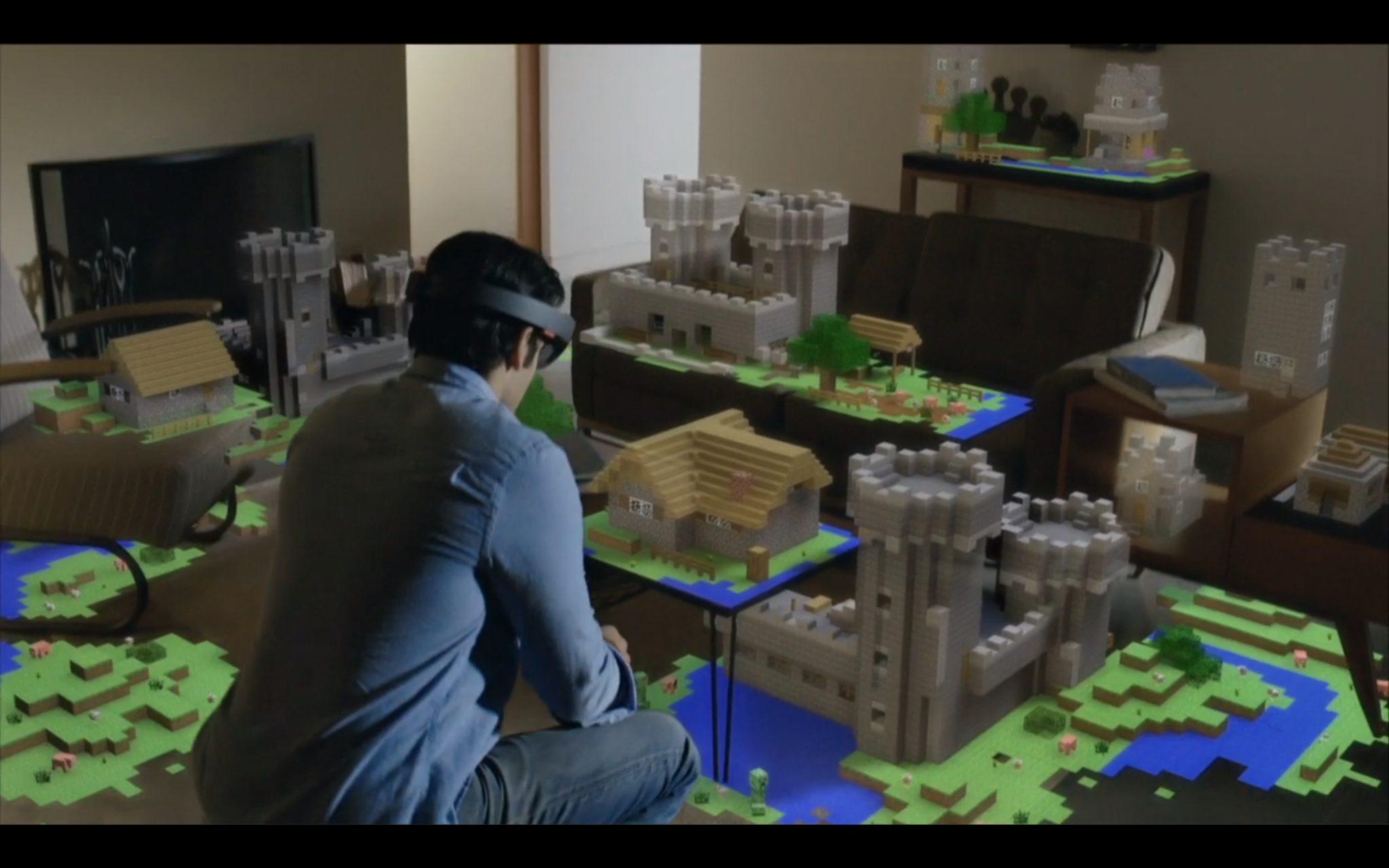B2C
When Will the VR Revolution Come for Marketers?
Have you tried virtual reality yet? It’s a pretty common question among marketing and media types, who are excited by the new technology as much as anyone. If you have tried it, in all likelihood you’ve used Google Cardboard, Facebook’s Oculus, or Samsung’s Gear.
Whether your mind was blown or you found the experience disappointing, I’ve got something to tell you: You haven’t seen anything yet.
Like the first smartphones, the VR headsets we’ve seen so far are little more than stepping stones to what some are hoping will revolutionize entertainment and communication. As they stand now, Google’s Cardboard, Facebook’s Oculus, and Samsung’s Gear all provide one of the major elements of virtual reality: interactive 360-degree video. When you turn your head with an Oculus, your point of view responds in turn, allowing you to look in any direction.
“The ability to interact in an environment, especially using your hands—which is your natural method of interaction in the real world—is sort of the golden chalice of VR.”
That’s a significant change from how current screens work, but as a standalone feature, it’s far from “revolutionary.” Many in the VR industry believe the technology will only take off when there are innovations in two realms: control and content.
“The ability to interact in an environment, especially using your hands—which is your natural method of interaction in the real world—is sort of the golden chalice of VR,” said Christine Cattano, the executive producer of Framestore VR, a creative studio that specializes in creating VR experiences.

That’s the promise of three devices that have been or will be released this year: HTC Vive, Playstation VR, and Oculus Touch. HTC Vive—which comes with an $800 price tag at launch and requires a powerful PC—comes with virtual reality controllers. PlayStation VR, which only runs on Sony’s PlayStation 4 gaming console, offers controller add-ons. And Oculus Touch—Oculus’ wireless controllers—is set to launch in the second half of 2016.

At Framestore, I had the chance to experiment with HTC Vive and experience the difference virtual reality controllers can make. Until now, most virtual reality gaming has been done using a traditional video game controller, which felt like playing a normal game except with a big screen strapped on your face.
Playing with the HTC Vive felt different. The device comes packaged with trackers that scan whatever space you’re in, meaning that when you take a step in real life, you take in step in the virtual reality environment as well. Admittedly, the movement was unsettling—at no time did I take a step forward without fearing I was going to fall. Still, the psychosomatic sensation of being in a virtual environment, rather than simply watching one, felt new. Painting my name in sparkly cursive, then walking around the floating text to view it from the opposite angle, felt properly sci-fi.

The VR controllers added a distinctly futuristic element to the experience. Motion controllers have been around for some time (remember the Wii?), but VR seems like the natural partner they’ve always been missing.
While these devices are set to be released this year, they may not achieve widespread market penetration until 2020. That’s partly because of the intimidating price tag. PlayStation VR, the cheapest of the bunch, will run $400 just for the headset, assuming you already have a PS4. Without a PS4 or the controllers and camera, the price jumps to $850. Mostly, however, it’s because the content just isn’t there yet.
Cattano compares early VR content with early film, which took years to evolve into its own art form. “The first film was a train coming into a station,” she said. “Super literal, right? Seven years later, Georges Méliès is doing crazy things that could only be done on film. It took enough experimentation. It took enough wacky minds and enough balls, frankly, to do stuff that is imaginative.”
She also believes that VR will not see widespread adoption until there are non-entertainment uses for daily life, such as social media (which Facebook seems to want with Oculus). That’s often where augmented reality, or AR, comes into the picture.
Augmented reality
AR is similar to virtual reality in that it is a wearable device strapped in front of your eyes. Except in this case, the display is broadcast onto the world around you.
 Christopher Mims, The Wall Street Journal’s technology columnist, recently proclaimed that AR is “the most exciting technology you’re ever likely to encounter” and “is the future, the dominant way we will interact with computers and the internet.” For Mims, and other technology analysts, AR is to VR what smartphones were to desktop computers. They’re the device that is constantly present, rather than one you use intermittently.
Christopher Mims, The Wall Street Journal’s technology columnist, recently proclaimed that AR is “the most exciting technology you’re ever likely to encounter” and “is the future, the dominant way we will interact with computers and the internet.” For Mims, and other technology analysts, AR is to VR what smartphones were to desktop computers. They’re the device that is constantly present, rather than one you use intermittently.
Facebook, for one, is making a bet that AR is the future of its communication empire. While it launched Oculus this year, Mark Zuckerberg seemed particularly excited at this year’s F8 keynote by these unnamed Facebook AR glasses.

They resemble Google Glass, the search engine giant’s 2012 failed AR experiment—but that experiment’s failure may have been more a matter of being too early to the game than anything. At least, that’s what Facebook seems to think. Zuckerberg claimed that AR could be as radical a transformation as mobile phones were: ” “A lot of the things we think about as physical objects today, like TVs, will just be one-dollar apps,” he said.
Snapchat, meanwhile, has been experimenting with a wearable AR device of their own, according to CNET. They’ve purchased glasses companies, built out a research team of AR experts, but they haven’t confirmed any of the reports. The move would make a lot of sense—as this Medium piece argues, Snapchat’s famous filters, geolocation, and illustration features are close to AR already.
But while Facebook and others think AR and VR could replace TV and perhaps even mobile phones, marketers have to be careful not to apply contemporary constructs to how they might use these futuristic devices.
“[Some advertisers] keep bringing up this vision of wearing some sort of augmented reality device and you’re walking down the street and the cool thing we’re going to do is… we’ll just serve more ads,” said Cattano. “Someone will definitely invent an ad blocker not long thereafter.”
Instead, Cattano believes that brands need to adapt to the format itself. “Essentially, VR is a user-first media,” she said. “It’s you, it’s your point of view. It’s your decisions, it’s where you choose to look. Shoving a brand message down their throat is not really the way that you want to approach this. … If it has a brand message, okay, but make sure it has value first.”
This is an excerpt from “Media 2020: The Marketer’s Guide to the Future of the Internet.”
Image by Hannah WaldronGet better at your job right now.
Read our monthly newsletter to master content marketing. It’s made for marketers, creators, and everyone in between.




